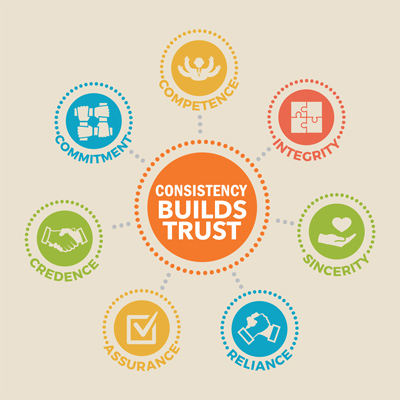As consumers and businesses consult multiple channels before making a purchase, here’s rationale and tips for delivering an omni-channel experience.
What helps to build connections with your audience is consistency of presentation, experience and messaging.
To connect with your audience (both current and future customers), it helps to be consistently present and visible, wherever they are. An omni-channel experience provides a customer (or prospect) the same experience across all touchpoints. This, as opposed to a customer having inconsistent experiences across multiple touchpoints, which would be a multi-channel experience. Multi-channel experiences, unfortunately, are far more common. But a truly omni-channel experience is what builds connectivity. In fact, as reported by Media DailyNews an Interactive Advertising Bureau (IAB) study shows that “consumers viewing a constant message across a variety of channels can improve purchase intent by 90% and brand perception by 68%.”
As ubiquitous as technology and internet-connected devices are, given your company has made the right preparations, you can be as available as a customer’s hand. The complexity often comes as you add tools to your marketing mix (website, mobile marketing, email, marketing automation, social media, direct mail, traditional media, packaging, sales people, customer service). Ensuring the customer has a consistent omni-channel experience across all touch points, be they technological or in the real world (IRW), can be challenging. But it’s also important. Research from Blue Nile shows that people consult three or more channels before making a purchase, and it doesn’t matter if it’s a business or consumer purchase.
Here are some tips to help build that consistency across channels:


Consistent Look
Be sure your logo, colors, typography, layouts, photography/illustration style are consistent. Create a style guide that addresses the important elements of consistency but leaves some flexibility so that you can capitalize on the opportunities that may be unique to a channel or tool.

Consistent Messaging
By having consistency in tone and content, your audience will become accustomed to the company voice and build assurance upon which they can rely. Watch the little things like making sure your brands are presented consistently in copy, as well as members of the leadership team. You’d be surprised how many times we’ve seen brand names or company leader names noted differently in copy, on the same page of a website or across social posts. Build a proofing guide that can be referenced by employees and vendors to help make sure that key elements are consistently and properly represented.

Consistent Product / Service
A consistent, well-conceived and executed marketing communications program will help set the appropriate expectation for your business in the marketplace. Be sure you remain true to that promise. YELP and Google reviews offer examples of companies whose product or service did and did not provide the customer with the experience that was consistent with their expectation. While it’s important to strive for zero defects, on those rare occasions where your team or product may fall short, be sure to address the customer’s concern, honestly and respectfully.

Consistent Interactions
If you are known for personal service in the real world, you should deliver that online too. Be sure to monitor your social accounts (if you use them) and respond to both praise and criticism. It takes a significant amount of effort and money to connect your company with customers, don’t risk running them off because of a poor experience along the value chain.
Creating an omni-channel experience can be challenging and rewarding. If you are using multiple channels, disparate internal teams and vendors to implement across channels, coordination is key to success.




